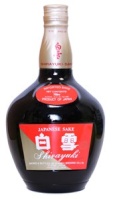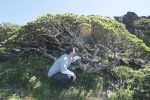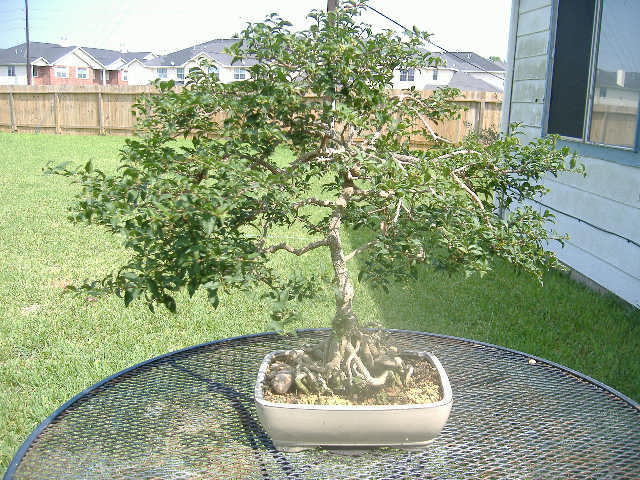Barbados Cherry
+2
landerloos
Ronald kelly
6 posters
Page 1 of 1
 Re: Barbados Cherry
Re: Barbados Cherry
If you want a "fatter" trunk the arial roots wil fatten aswell, dont think you can stop them from fusing together, arial roots are like branches and they wil get more fat in time.
Kind regards from snowy Denmark
Peter
Kind regards from snowy Denmark
Peter
Last edited by landerloos on Wed Feb 17, 2010 9:34 pm; edited 1 time in total (Reason for editing : Typo)

landerloos- Member
 Re: Barbados Cherry
Re: Barbados Cherry
Repot your plant into a colander (kitchen utensil for draining pasta) of suitable size. Use a very open soil mix for the colander. before potting the tree, make one or two bigger holes at the bottom of the colander. Select one or two roots from the tree which are long, and located in a position which will not affect the shape of the root mass. Thread these roots through the holes in the colander. Pot the tree in the colander, you will have one or more long roots coming out of the bottom of the colander. Then, place these roots in a training pot filled with rich compost. The colander will sit on top of the other bigger pot. The idea is that the roots going through the colander will grow and spread in the training pot, drawing energy to the plant above, while the roots in the colander, growing in a less rich soil, will not grow much. The roots escaping through the holes in the colander will thick considerably, helping to thicken the trunk and branches of the tree. These are sacrifice roots, and when the tree gets to the desired thickness, you will cut these roots and repot the tree back into a bonsai pot.
For this technique to work, you will also need to allow one or more lower branches to grow unchecked, while keeping the remaining branches under control. These unchecked branches are the branches which will grow wild and help thicken the trunk of the tree, this strong growth supported by the sacrifice roots. These branches are also sacrifice branches, and you will cut them out at their base once the tree has achieved the desired thickness. These sacrifice branches should be located on the back of the tree, so that the scars after you cut them will not be visible from the front of the tree.
I hope this helps.
Cheers,
Marlon Machado
Bahia, Brazil.
For this technique to work, you will also need to allow one or more lower branches to grow unchecked, while keeping the remaining branches under control. These unchecked branches are the branches which will grow wild and help thicken the trunk of the tree, this strong growth supported by the sacrifice roots. These branches are also sacrifice branches, and you will cut them out at their base once the tree has achieved the desired thickness. These sacrifice branches should be located on the back of the tree, so that the scars after you cut them will not be visible from the front of the tree.
I hope this helps.
Cheers,
Marlon Machado
Bahia, Brazil.
Marlon Machado- Member
 Re: Barbados Cherry
Re: Barbados Cherry
Ronald,
Malpighia Pendiculata or what you refer to as barbados cherry is and extremely slow grower. The colander method will not work with this species. I suggest for your to place the tree in a big pot and let it grow. With time a bigger trunk will develop. If you want to try out a faster malpighia, try to find M. Glabra or Punicifolia. These develop hefty trunks.
also, beware of sacrificial branches on malpighia. If unchecked, sap withdrawal will occur.
On another note, malpighias are prone to nematodes. In order to prevent this, place some crushed crab, lobster or shrimp shell on the mix. The microorganisms that feed on these will also feed on whatever nematodes are present in the soil.
Kind regards,
Jose Luis
Malpighia Pendiculata or what you refer to as barbados cherry is and extremely slow grower. The colander method will not work with this species. I suggest for your to place the tree in a big pot and let it grow. With time a bigger trunk will develop. If you want to try out a faster malpighia, try to find M. Glabra or Punicifolia. These develop hefty trunks.
also, beware of sacrificial branches on malpighia. If unchecked, sap withdrawal will occur.
On another note, malpighias are prone to nematodes. In order to prevent this, place some crushed crab, lobster or shrimp shell on the mix. The microorganisms that feed on these will also feed on whatever nematodes are present in the soil.
Kind regards,
Jose Luis

jrodriguez- Member
 Re: Barbados Cherry
Re: Barbados Cherry
jrodriguez wrote:Ronald,
On another note, malpighias are prone to nematodes. In order to prevent this, place some crushed crab, lobster or shrimp shell on the mix. The microorganisms that feed on these will also feed on whatever nematodes are present in the soil.
Kind regards,
Jose Luis
You learn something everyday....good one Jose Luis!
Q
pine queen- Member
 Similar topics
Similar topics» Fertilizer for Weeping Barbados Cherry?
» barbados cherry
» Barbados cherry landscape
» Help identify this plant
» Barbados cherry in 2 years progression
» barbados cherry
» Barbados cherry landscape
» Help identify this plant
» Barbados cherry in 2 years progression
Page 1 of 1
Permissions in this forum:
You cannot reply to topics in this forum







